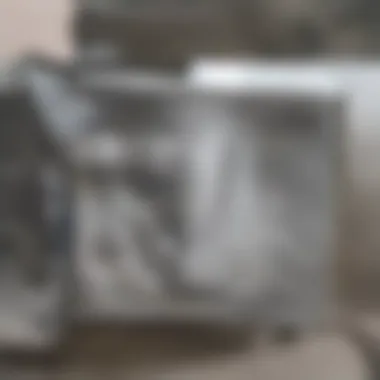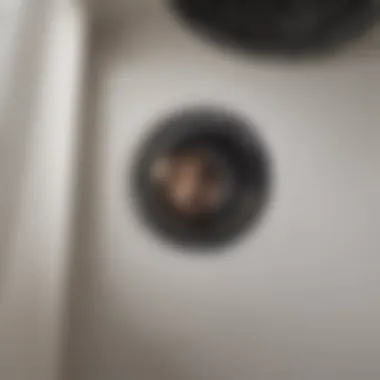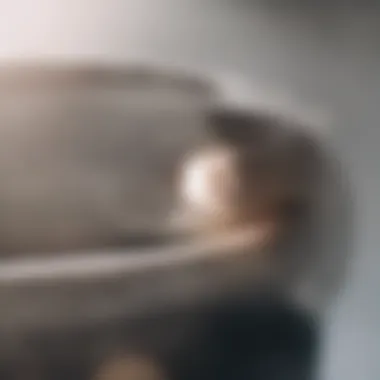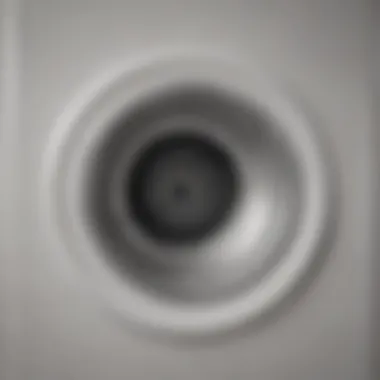Thorough Guide to Cleaning Whirlpool Dryer Vents


Intro
Maintaining a dryer vent is a crucial aspect of home management, especially for owners of Whirlpool dryers. Regular cleaning prevents lint buildup and optimizes the appliance's efficiency. This guide delves into the necessary steps for cleaning Whirlpool dryer vents while emphasizing the importance of this task for safety.
Clogged dryer vents can lead to significant issues, including increased drying times and heightened fire risks. Understanding the cleaning process will empower homeowners to take charge of their dryer maintenance, ensuring their appliance operates at peak performance.
Utilizing the right tools and following a systematic approach will simplify the task. This guide focuses on practical advice, common challenges, and proactive measures to maintain clear dryer vents.
Importance of Cleaning Dryer Vents
Cleaning dryer vents is not just a chore, but a critical maintenance task that can profoundly influence the performance of your Whirlpool dryer. An overlooked vent can lead to a series of complications, affecting both the appliance and your home. This section delves into the specific elements of importance regarding dryer vent cleaning, emphasizing effects on appliance efficiency, fire safety, and energy costs.
Impact on Appliance Efficiency
A clean dryer vent significantly enhances the appliance's efficiency. When lint and other debris accumulate in the vent, airflow is restricted. This blockage forces the dryer to work harder to expel moisture from clothes. As a result, the appliance consumes more energy and takes longer to dry laundry. By maintaining a clear vent, you ensure optimal airflow, allowing your Whirlpool dryer to operate as intended. Additionally, an efficient dryer experience less wear and tear, extending its lifespan.
Fire Safety Considerations
Dryer lint is highly flammable, making cleaning the vent crucial for home safety. According to the U.S. Fire Administration, clogged dryer vents are a leading cause of household fires. When lint builds up, it can ignite from the heat generated during the drying process. Regular cleaning of the vent minimizes this risk. Homeowners should prioritize vent cleaning as part of their safety protocols to protect lives and property.
"The leading cause of residential dryer fires is failure to clean the dryer vent."
— U.S. Fire Administration
Saving on Energy Costs
A little investment in cleaning can lead to significant savings on energy bills. When vents are clear, dryers run more efficiently. This efficiency means less energy consumption over time, resulting in lower utility bills. As appliance performance improves, homeowners will notice the difference on their energy statements. Also, regular maintenance can prevent costly repairs or replacements, further supporting financial savings.
Understanding Your Whirlpool Dryer
Models and Specifications
Understanding the specific models and their specifications is vital when cleaning a Whirlpool dryer. Each model may have unique features that can affect the design of the venting system. For instance, models like the Whirlpool WED4815EW and the Whirlpool WED7000DW come equipped with different drying cycles and configurations. Knowing your dryer model ensures you have the right approach and tools for cleaning the vent.
Homeowners should familiarize themselves with the technical manuals provided by Whirlpool. These manuals often outline not only the specifications of the dryer but also offer guidance on maintenance, including vent cleaning. This information is crucial for effective cleaning.
Vent System Overview
The vent system in a Whirlpool dryer plays a critical role in its performance. It comprises various components designed to expel the moist air from the dryer. Understanding how the vent system works can help homeowners recognize potential issues.
Typically, the vent includes:
- The vent duct: This directs the hot, moist air outside.
- The vent hood: This prevents backdrafts and can be a point of lint buildup.
- The clamps and connections: These secure the venting system, which requires checking for wear or damage during cleaning.
Maintaining a clean vent system not only improves dryer efficiency but also reduces the risk of fire hazards. Clogged vents can cause lint to accumulate at various points, obstructing airflow. Consequently, this could lead to overheating and potentially dangerous situations.
By regularly reviewing the vent system, understanding how airflow works, and knowing where clogs are most likely to occur, homeowners can ensure their Whirlpool dryer operates safely and efficiently.
Tools Required for Cleaning


Cleaning the dryer vent is an essential part of home maintenance. Having the right tools ensures efficiency and can also make the task easier. Understanding what tools to use can save you time and help maintain the safety of your appliance. Improperly cleaned vents lead to reduced efficiency and increased fire hazards. Therefore, selecting appropriate tools is not just beneficial; it's necessary.
Basic Cleaning Tools
Before starting the cleaning process, it's important to gather some basic tools. Here is a list of essential items:
- Vacuum Cleaner with Attachments: A vacuum equipped with various attachments can help you reach tight spaces and remove lint effectively.
- Lint Brush: This tool is specifically designed to eliminate lint that clogs the dryer vent. It has flexible bristles that can reach into ducts without damaging them.
- Screwdriver Set: Various screws hold the vent together. A set of screwdrivers allows you to dismantle your dryer vent properly for cleaning.
- Duct Tape: Useful for any temporary seals you may need while cleaning or reassembling your vent system.
- Gloves: Disposable gloves protect your hands from dirt and grime during the cleaning process.
Having these basic tools at your disposal not only simplifies the process but also ensures you are prepared for any cleaning scenario you might encounter.
Professional Tools and Equipment
For those who prefer a more thorough clean or are dealing with more significant issues, professional tools and equipment can be beneficial. These tools often provide greater efficiency and thoroughness:
- Air Blower: This tool combines a source of compressed air and various nozzle attachments. It helps in blasting away stubborn lint buildup.
- Camera Inspection Tools: These tools allow you to inspect the inside of the venting system visually. They can identify hidden clogs or damages effectively.
- Professional Dryer Vent Cleaning Kits: A complete kit usually contains brushes and rods that extend into the duct. It often includes specialized brushes that can navigate bends in the duct.
- Rotary Cleaning System: This tool attaches to the vacuum cleaner and rotates to agitate and remove lint from the walls of the vent.
Ultimately, investing in professional tools can significantly enhance the efficiency of the cleaning process, helping to maintain the performance of your Whirlpool dryer long-term.
Step-by-Step Cleaning Process
The step-by-step cleaning process is a crucial aspect of maintaining your Whirlpool dryer. Effective cleaning not only enhances the performance of the appliance but also significantly contributes to safety in your home. Following a structured approach ensures that all components are thoroughly addressed, minimizing the risk of overlooking essential parts that may harbor lint and debris.
This methodical process allows you to identify potential problems during cleaning. Recognizing issues early can prevent costly repairs or replacements. By systematically approaching each task, you can maintain the appliance in optimal condition and sustain its lifespan.
Through this section, we will detail each phase of the cleaning process, emphasizing its importance for appliance efficiency and safety.
Preparing for Cleaning
Before starting the cleaning process, preparation is key. Ensure you turn off and unplug your Whirlpool dryer to avoid any electrical hazards. Clear the area around the dryer for better access. Having a clean work surface aids in keeping all tools organized.
Gather all necessary tools and supplies. This can include a vacuum cleaner with a hose attachment, a screwdriver for disassembly, and a lint brush. Some users may find it beneficial to have a flashlight to illuminate darker areas of the vent.
Disassembling the Dryer Vent
Once you have prepared the space, the next step is to disassemble the dryer vent system. This typically involves removing the vent from the back of the dryer and disconnecting it from the wall. Use a screwdriver to loosen any clamps or screws holding the vent in place.
Care should be taken during disassembly. Avoid applying excessive force as you could damage the connectors or the dryer itself.
Removing Lint and Debris
With the vent disconnected, it is essential to remove lint and debris buildup. Start at the vent opening of the dryer. Use a vacuum cleaner to remove loose lint. You can also gently use a lint brush to dislodge stubborn clumps.
Make sure to check both the inner and outer sections of the vent system. A high concentration of lint buildup can occur particularly in bends or turns of the duct. Removing this buildup is critical to enhance airflow and efficiency.
Cleaning the Vent Duct
After you have cleared the lint, it is time to clean the vent duct. You can do this with a duct cleaning brush. Insert the brush into the duct and rotate it gently as you pull it out. This method helps to remove any remaining lint or dirt.


For cases with heavy buildup, you may need a specialized dryer vent cleaning kit, which often includes long brushes and tools designed specifically for reaching deep inside the ductwork.
Inspecting for Damage
Once the duct is cleaned, inspect it carefully for any signs of damage. Look for cracks, holes, or wear in the material. Damage can lead to airflow restrictions or even potential fire hazards. If you find any issues, consider replacing the affected parts to ensure the vent system is intact.
Reassembling the Vent System
After cleaning and inspecting, reassemble the dryer vent system. Ensure all connections are secure. It is important to avoid overtightening, which can lead to damage. Check that the vent is straight without excessive bends, as this can impede airflow.
Testing the Dryer
Finally, it's essential to test the dryer after completing the cleaning process. Plug the dryer back in and run a short cycle to ensure it operates normally. Check for adequate airflow from the exterior vent. If you notice any issues like strange noises or restricted airflow, further investigation might be necessary.
This organized step-by-step cleaning process ensures that your Whirlpool dryer functions safely and efficiently. Regular maintenance like this is essential for preventing dangerous lint buildup and promotes a longer lifespan for the appliance.
Common Problems and Solutions
Cleaning Whirlpool dryer vents is essential for maintaining their efficiency and safety. Common issues that arise in dryer vent systems can lead to inefficiency and hazards. Addressing these problems promptly can prevent costly repairs and mitigate fire risks. Here, we discuss some prevalent issues and their solutions to maintain optimal operation of your dryer.
Clogs and Blockages
One of the most common problems with dryer vents is the buildup of lint, dust, and other debris. Over time, this can create significant clogs that obstruct airflow. Clogs lead to longer drying times, excess energy usage, and potential overheating of the appliance.
To address clogs, it is crucial to inspect the vent regularly. Homeowners should look for any signs of blockage, like slower drying cycles or increased lint accumulation around the dryer.
Solutions:
- Regularly Clean the Vent: Schedule cleaning sessions every six months, or more frequently if you notice problems.
- Use a Vent Brush: Invest in a vacuum attachment with a long hose designed for this purpose.
- Check Vent Path: Ensure no sharp bends or kinks in the venting pipe, as they can trap lint more easily.
Important: A thorough cleaning not only enhances efficiency but also significantly lowers the risk of fire. Make this a priority.
Odors and Airflow Issues
Another indicator of a problem with your dryer vent is unusual odors. Lint, moisture, and debris can create a musty or burnt odor emanating from the dryer or the vent. These smells can be more than just unpleasant; they may indicate airflow issues that could lead to more significant problems like overheating or fires.
Airflow issues commonly arise from restricted vents. Restricted airflow causes the dryer to work harder, leading to wear and tear on the appliance and potential breakdowns.
Solutions:
- Identify the Source of Odor: Check the exhaust vent and lint trap for accumulated debris.
- Improve Airflow: Make sure the exhaust vent is clear and that there are no obstructions around the dryer.
- Consider Upgrades: If your system is older, consider upgrading to a more efficient vent system that promotes better airflow.
Through understanding these common problems and their solutions, homeowners can take proactive measures to maintain their Whirlpool dryers, ensuring they function at their best while minimizing risks.
Preventative Maintenance Tips
Maintaining your Whirlpool dryer vents is essential not just for performance, but also for safety. Preventative maintenance can significantly reduce the risk of fire, improve energy efficiency, and extend the lifespan of your appliance. This section delves into essential practices that keep your dryer vents clean and functional.


Regular Cleaning Schedule
Developing a regular cleaning schedule is crucial for efficient dryer operation. Ideally, you should clean the vents at least twice a year. This frequency can help prevent lint buildup, which is a primary cause of reduced airflow and fire hazards. Here are some tips for establishing a cleaning schedule:
- Create a Calendar Reminder: Marking your calendar can be an easy way to remember when to check your dryer vents.
- Combine with Other Household Chores: Integrate dryer vent cleaning with seasonal cleaning tasks like changing air filters.
- Involve Family Members: Assign responsibilities to ensure that the task is not overlooked.
Regular checks will facilitate early detection of clogs and buildup. It can keep your appliance running smoothly and save on energy costs.
Upgrading Vent Components
Sometimes, cleaning is insufficient. Upgrading vent components can lead to even better performance. Consider these upgrades:
- Smooth Ducts: Replace flexible ducts with smooth metal ones. Metal ducts allow for easier airflow, reducing lint accumulation.
- Proper Vent Hood: Install vent hoods that prevent outside air from entering while allowing air to escape.
- Damper Maintenance: Ensure that dampers are functioning properly. They should open easily and close tightly.
While upgrading components may involve an initial investment, the long-term benefits include enhanced dryer efficiency and safety. Always consult an expert if you are unsure about which components to upgrade, as they can provide recommendations based on your specific needs.
"Preventative maintenance is key. It saves time, money, and keeps your home safe."
When to Call a Professional
Cleaning your Whirlpool dryer vents is crucial for safety and efficiency. However, there are instances where enlisting a professional’s help is the best course of action. Understanding when to call in an expert can save you from potential headaches and ensure your appliance operates at its peak.
Signs of Major Issues
Recognizing the signs that indicate the need for professional intervention can make a significant difference. Here are several indicators to be aware of:
- Dryer Performance Decline: If your dryer takes longer to dry clothes than usual, this may signal a buildup of lint or other debris in the vent system. Waiting too long can exacerbate the issue.
- Unusual Noises: Strange sounds coming from your dryer, such as rattling or grinding, are potential symptoms of a more serious underlying problem. It could relate to the motor, the fan, or even an obstructed vent.
- Excessive Heat: After a drying cycle, if the exterior of the dryer feels unusually hot, this could suggest that airflow is restricted. Overheating can lead to appliance damage or even fire hazards.
- Visible Lint Around the Dryer: If you notice lint accumulating around your dryer, it is an obvious indicator that your venting system is not working effectively.
- Frequent Overheating Error Codes: Many modern dryers come equipped with error codes. Repeated warnings about overheating or airflow issues should not be ignored, as these can point to serious problems.
It is essential to address these signs promptly. If you identify any combination of these factors, it may indicate a critical failure that calls for a specialist.
Benefits of Professional Services
Opting to hire a professional for dryer vent cleaning and maintenance provides several advantages:
- Expertise and Experience: Professionals bring a wealth of knowledge and experience to the table. They can efficiently handle complex systems that might overwhelm a homeowner.
- Deep Cleaning: Equipped with specialized tools, a technician can perform a thorough cleaning that goes beyond what a homeowner might achieve. This ensures that even hidden lint and debris are removed, enhancing both safety and efficiency.
- Preventative Maintenance: Often, professional services include inspections that can identify potential issues before they become significant problems. This foresight can save time, hassle, and additional costs in the future.
- Assessment and Repair: Along with cleaning, professionals can assess other components of your dryer system for wear and tear, providing recommendations for necessary repairs or replacements.
- Peace of Mind: Knowing that a qualified technician is handling your appliance allows homeowners to rest easy, avoiding the stress that can come with DIY repairs.
The End
Cleaning the dryer vent is not just a routine task; it’s a critical component of maintaining both safety and efficiency in your home. The lengthy guide discussed various aspects of this process, highlighting essential elements that every homeowner needs to keep in mind. Regular maintenance of Whirlpool dryer vents can effectively prevent fire hazards, improve appliance efficiency, and reduce energy costs. Each step outlined in the cleaning process serves a clear purpose, from disassembling the vent to thoroughly inspecting for damage.
Moreover, understanding when to seek professional help can save homeowners from potential injuries or extensive damages. By adhering to the preventative maintenance tips discussed, you can ensure your dryer continues to operate at optimal levels.
Recap of Key Points
- Importance of Regular Cleaning: Regularly cleaning your dryer vent protects your home from fire risks and keeps your dryer running efficiently.
- Step-by-Step Process: The detailed step-by-step process ensures that you don't miss any crucial element during the cleaning, from preparing the workspace to testing the dryer afterward.
- Professional Help: Recognizing signs of major issues can lead to quicker resolutions through expert intervention, preventing further problems.
- Preventative Measures: Establishing a cleaning schedule and upgrading vent components can minimize future buildup.
Encouragement for Home Maintenance
Home maintenance is often seen as a daunting task, but it doesn’t have to be. By taking proactive steps to clean your Whirlpool dryer vent, you enhance your home’s safety and appliance longevity. Consider setting a regular interval for cleaning, perhaps bi-annually or after a certain number of loads dried.
Engaging in this task not only fosters a sense of responsibility toward your property but also equips you with the knowledge necessary for troubleshooting minor issues. Remember, a well-maintained appliance not only aids in efficient performed tasks but contributes to peace of mind within your living space.
"An ounce of prevention is worth a pound of cure."
Commit to the routine, and you will reap the benefits of a safer and more efficient home.















